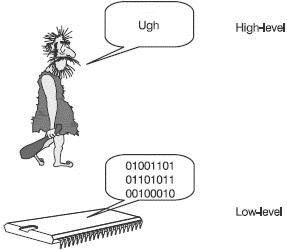Книга: Introduction to Microprocessors and Microcontrollers
The problems with machine code
The problems with machine code
There are so many. The program is not friendly: 11000110 00010101 hardly compares with ‘Add 15H to the number 25H’ for easy understanding. There is nothing about 11000110 which reminds us of its meaning ‘add the following number to the number stored in the accumulator’ so a program would need to be laboriously decoded byte by byte.
Typing in streams of ones and zeros is so boring that we will make many mistakes, particularly when we remember that a real program may be ten thousand times longer than this. Can you imagine typing in half a million bits, finding the program does not run correctly and then settling down to look for the mistakes?
Another problem is that the programmer must be aware of the internal structure of the microprocessor. How else could you know which register to use, or even which registers exist? So you master all this and then change to another microprocessor and then what? The whole learning process has to start again – new instructions, new registers, and new coding requirements. It’s all too horrible.
The difficulties with machine code hardly mattered in the early days of the microprocessor. Everyone who programmed them were fanatics and loved the complexity and there were few serious jobs for the microprocessor to do. This first program language was called a ‘low-level’ language to differentiate it from our own verbal communication language which was called a high-level language. Machine code was later referred to as the ‘First generation’ language (see Figure 9.4).

Figure 9.4 High-and low-level languages
Very soon, the microprocessor was used for an increasing range of tasks and revolutionary ideas like ‘speed and ease’ crept into the discussions. This resulted in a new language called Assembly which overcame the most immediate failings of machine code.
- 9. Programming – using machine code and assembly
- 1.3.2 ... because the world is asynchronous
- 1.4 About the examples in this book
- The Problems That Perfection Makes
- Chapter 16. The Problems We Face
- Системные переменные ROWS_AFFECTED, GDSCODE, SQLCODE, TRANSACTIONJD, CONNECTIONJD
- 4.4.4 The Dispatcher
- About the author
- Chapter 7. The state machine
- Appendix B. Common problems and questions
- Appendix E. Other resources and links
- Appendix J. Example scripts code-base




